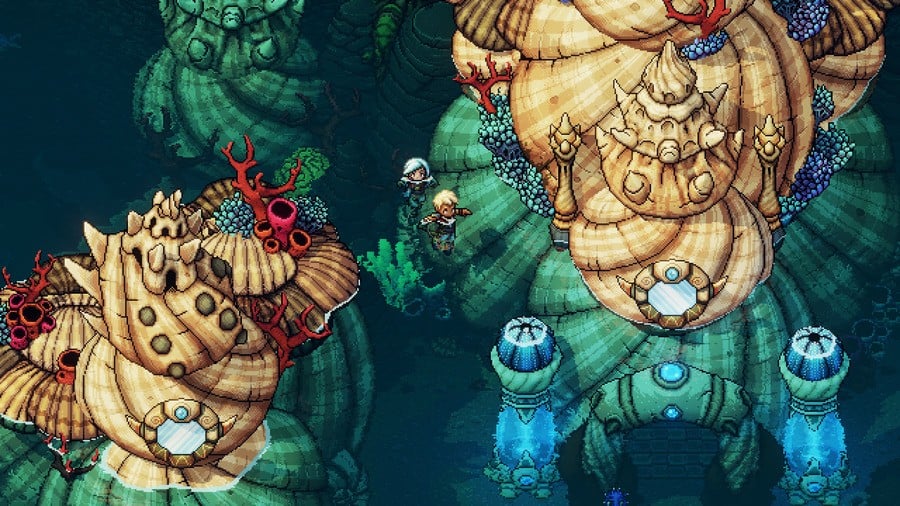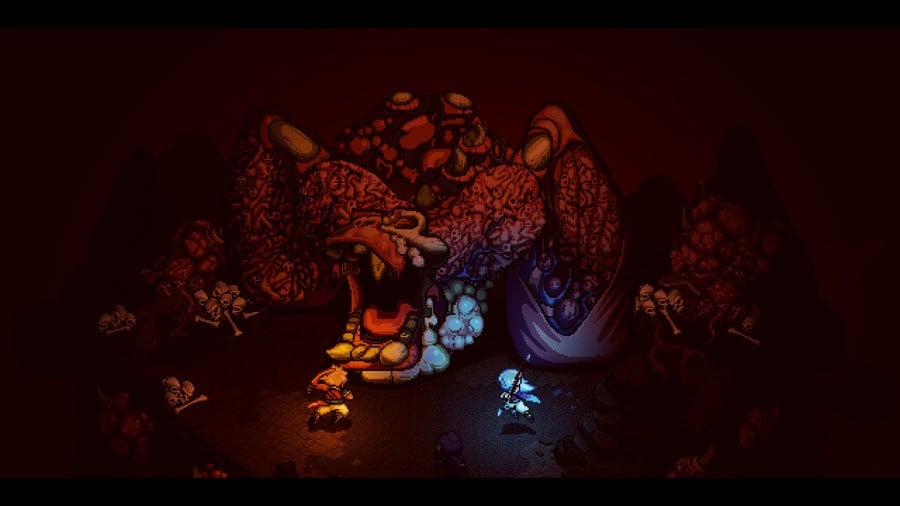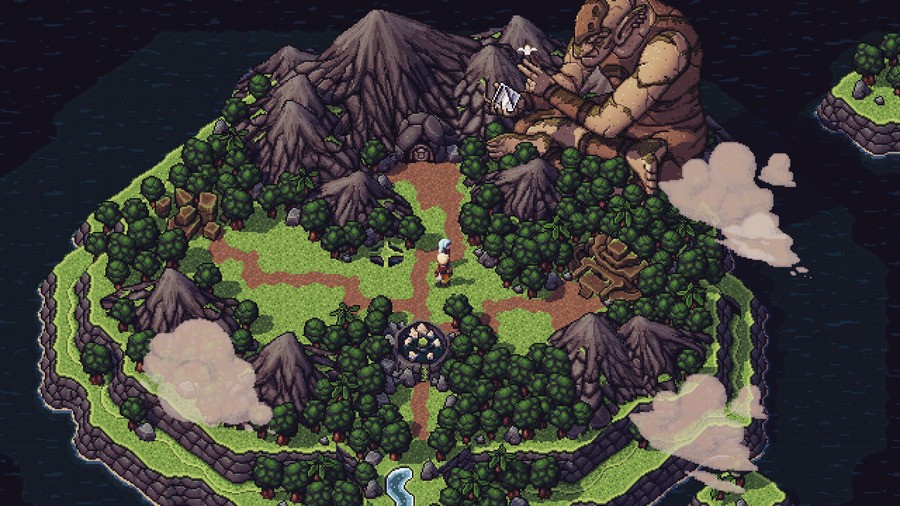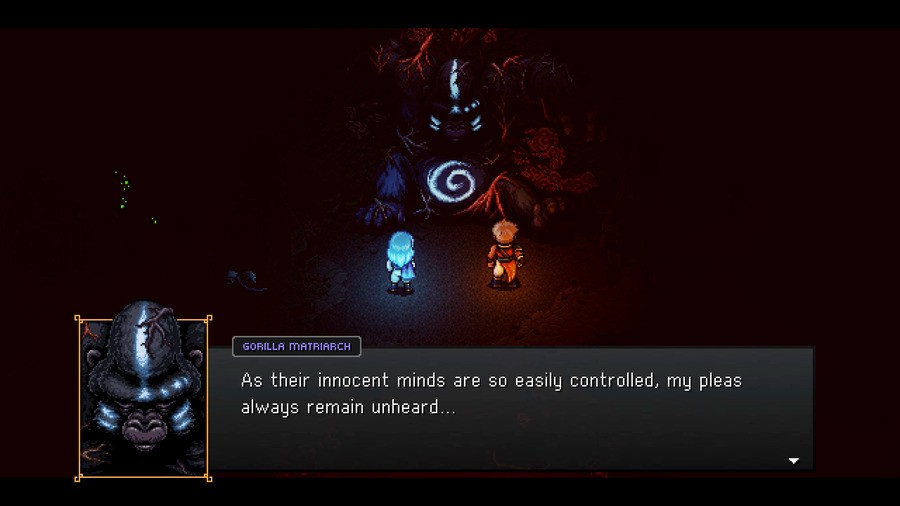There is certainly no shortage of retro-inspired titles across all platforms these days. In fact, it can sometimes feel like every other game is a pixel art 'homage' to a retro classic. Still, when those games are done well and do more than fondle your nostalgia zones, the results can be potent. Sabotage Studio's first game, The Messenger, did just that, setting expectations through its appearance and references at the beginning before slashing through every last one in spectacular fashion. It was a throwback, but one with more to offer than a knowing wink, and one with a twist that tied into its narrative beautifully.
Sabotage had intended to reveal its next project, an expansive turn-based RPG named Sea of Stars, at GDC this year through a hands-on demo, but COVID-19 scuppered those plans. Instead, we were invited to view an appropriately hands-off video demo hosted by Sabotage CEO and Creative Director Thierry Boulanger after which we spoke one-on-one via the magic of the internet and quite rightly maintaining our social distance. While we were disappointed not to be able to get our mitts on it this early build, the remote demo gave us a good idea of the direction Sabotage is taking, and we have to say it looks very promising indeed.
Sea of Stars exists in the same universe as The Messenger and ties in explicitly to its lore, but is set many thousands of years in the past. Where the first game looked back at games like Ninja Gaiden for inspiration, Sea of Stars is taking classic 16-bit RPGs (think Chrono Trigger) as the jumping off point for a new, modernised take on the genre.
Built in Unity, Sea of Stars follows aspiring youths Valere and Zale who are training to become Solstice Warriors with powers drawn from the Sun or Moon which they will use to battle the evil of the Fleshmancer, a big bad threatening worldwide apocalypse though his army of unattractive minions and 'dwellers', the imposing bosses you'll encounter throughout the game.
It's a dual protagonist narrative and you choose one of the two characters as party leader (there'll be six party members in the final game) at the beginning, although according to Boulanger this affects only flavour text and the personality that comes across strongest throughout the story. Narrative outcomes will be the same regardless of your pick, so you won't need an entire second playthrough to get the 'proper' ending. Those of you with the backlog blues can breathe easy.
we assumed the bridge, the high ledges and the water were all gates blocking access to new areas which we would need a power bracelet or some such magical doohickey to swim, jump or climb to... but no.
"It won't be a branching story or the-choices-that-you-make or who is the most important in the end," Boulanger says. "It's about the two characters, but you only get to control one." Your chosen player takes centre stage and may get first response in conversations or acknowledgement from villagers, but the meat of the experience will be the same whether you go for staff-wielding, heavy-hitting Moon-girl Valere or the agile 'blade dancing' Summer Solstice Sun-boy Zale.
In fact, the focus of this retro-flavoured RPG is on trimming away the fat and tedium of the past, something that's immediately evident from the demo we saw. It took place on Watcher Island, the first of six planned landmasses you'll find on the ocean and home to a massive statue overlooking the island and its inhabitants. After a short initial battle on the shore, Thierry moved north along a jungle path area past a lagoon with a half-built bridge jutting from the edge. Having played our fair share of RPGs, we assumed the bridge, the high ledges and the water were all gates blocking access to new areas which we would need a power bracelet or some such magical doohickey to swim, jump or climb to...

But no. Thierry dives into the water immediately and both characters happily scramble up ledges and hoist themselves over scenery. Yes, there will almost certainly be inaccessible areas and progression gating techniques employed, but shoulder-high obstacles don't seem to cause a problem for the main characters and our immediate impression (beyond how lovely everything looks, more on which later) was how open and freeing the traversal of this world appears to be compared to the traditional top-down RPG.
Boulanger brings up the three Cs when asked about this: camera, character and controls. "At least in a few retro titles, it seems like the controls [...] no-one seemed to care sometimes, you know? You were bound to a grid and there was nothing engaging about traversal - it was all about the combat. Which is fine, the combat was great in those games." However, the approach to Sea of Stars is to "fix some of the tedium" while incorporating all the progression systems and genre mechanics you'd expect to find, in some form or other.
Speaking of mechanics, when you bump into (avoidable) onscreen enemies, there's no separate fight screen. Battles occur in the overworld and, as you'd expect, combat is turn-based. However, effective attacks require real-time input from the player, with timed button presses (which differ according to the attack) increasing the effectiveness of strikes. They quickly become essential.
"Your input always matters. No matter which action you do, player input can influence to get a better outcome," says Boulanger of this skill-based system. One example from the demo saw Valere playing 'tennis' with an enemy via timed button presses to deflect an energy-charged Moon-boomerang, bringing to mind Link's Forest Temple match against Phantom Ganon in Ocarina of Time. Another time an attack required mashing to power up a fireball. Player input is an integral part of turn-based combat here.
This skill-based approach to battle will be fundamental in defeating Sea of Star's more challenging enemies and is one of the ways Sabotage is creating a range of deep gameplay options and outcomes without resorting to the sorts of strict levelling systems that arguably belaboured the point in the old days. "The intention is to arrive at an experience where your character progresses along with the story" Boulanger tells us.
Sea of Stars' lack of random encounters means less of a reliance on that old-school levelling approach and a stronger focus on pattern recognition, learning and exploiting weaknesses, and improving execution.
Say you were banging your head against the brick wall of a particular boss in a traditional RPG. You'd probably have to go grind XP from random encounters in the overworld, purchase potions and equip better gear before traipsing back through dozens of unavoidable battles for another try at the boss. Sea of Stars' lack of random encounters means less of a reliance on that old-school levelling approach and a stronger focus on pattern recognition, learning and exploiting weaknesses, and improving execution. "You saw the animation, the patterns," Thierry explains, "so then you can hone your inputs better next time around to block better." It's a more engaging way to play that sidesteps the grind.
Enemies shed droplets of energy when hit which you can absorb to recharge the mana meter that powers each character's elemental attacks. Enemies can charge spells composed of multiple different moves but they can be diminished by striking with specific attacks. Read the signals, manage your mana effectively and strike in time to reduce the potency of the incoming spell or cancel it completely; fail to do so and even minor enemies can cause big problems for your party, let alone the elites that pop up periodically or the massive bosses you'll come across.

Given the active input system and the wider goal of stripping away tedium and filler, there's no need for an 'auto-battle' option here. Indeed, Boulanger says the team is considering permadeath for enemies, although he emphasises that it's just a possibility at this early stage. "We're just a few months in and there's two years left [...] We try to let it emerge as what it's trying to be. That process - there's a lot of iterations that go into it, but nothing is off the table."
"It's doing things that 2D sprite games shouldn't do with lighting"
Despite the game being only a few months into production, Sea of Stars is already a real looker. It's 16-bit at heart, but not really. The headlining feature is a totally dynamic lighting system reflecting the time of day (which you'll be able to control later in the game). We witnessed time fast forwarded at will in the demo. Shadows lengthened and the moon came out, which in turn activated a lunar rune engraved in a rock and revealed a secret cavern.
Playing with dynamically rendered shadows and controlling the sun and moon is just the start, though. "It's doing things that 2D sprite games shouldn't do with lighting," Boulanger states excitedly, and side-by-side comparisons with genuine 16-bit titles aren't required to see that. The bio-luminescence of underwater plants refracts through the surface with beautiful ripple effects, character sprites (also dynamically lit) are reflected in puddles, glowing stones in dark dungeons function as valuable light sources. It's a gorgeous looking game even at this stage and beyond the obvious genre touchstones it brought to mind Square Enix's Octopath Traveler in the way it takes a vintage look but turns everything up to 11 using the power of modern hardware. In fact, Sabotage is twisting the knob right off the dial here.

The vertical slice put together for GDC is impressive and could easily give the impression that Sea of Stars is further along than it is. With a projected release date of 2022, we'll be well into the next console cycle by the time it comes out and Sabotage is (understandably) a little vague when asked about targeted platforms. A lot of things are still up in the air in this transitional period, but Boulanger reassures us that the team is is confident in its ability to scale the game to relevant platforms accordingly and take advantage of platform-specific features (he mentions HD rumble as particularly interesting to play with). The PC build we saw looked great on a monitor, although holding our Switch up to the screen the text would be a mite small in handheld mode, so it's good to know the team is conscious if these things.
"we're investing everything we made from our first game"
Bearing in mind the key visual twist in The Messenger (spoilers, by the way) which saw the game jump from an 8 to 16-bit-style presentation and become more of a Metroidvania, we wondered if we can expect something similar in Sea of Stars. "Our main driver is stories," says Thierry. "The 8 and 16-bit in The Messenger was just the best way to properly tell the story of the ninja travelling into the future. Hey, let's skip ahead one console generation! [...] That was a big twist in the story and it was accompanied by the best way we could mindfully apply our craft to convey that story."
Boulanger is confident that Sea of Stars takes things up a gear from the previous game. "It's a better story, it has more twists and more unexpectedness." Sabotage is keen to build a shared universe between all its games, and we are assured that there will be plenty of story threads for fans of the previous game to pick up on in this prequel, although we probably shouldn't expect a big inter-generational visual leap in this one. "Asset creation in an RPG is already such a big deal I don't think we can afford to do it twice!" he jokes.

Having viewed the demo and the game's level of polish even at this early stage - and given the success of The Messenger - it begged the question of why Sabotage was turning to crowd-funding with Sea of Stars. "The short of it is that we're investing everything we made from our first game," Boulanger explains. "We believe in the theme, we believe in our next idea, but there's still two years left ahead of us and that's 16 people, full-time, paid at market value." In other words, games - good games - are damned expensive to make.
Sabotage seems committed to respecting not only the traditions of classic 16-bit RPGs but also the modern gamer's time.
The team is well aware that Kickstarter really can't provide the sums required to fund a game of the scale they have in mind, so while providing a useful cash injection the Kickstarter will function primarily as barometer of public opinion; a validation, of sorts, to make absolutely sure the audience is on-board with the studio's direction. "We want people to tell us in a concrete way that yes, I want to play this, I will be there in the end if you guys take this home. We're really committed to the project, it's definitely what we want to do, but it's a big risk."
The demo gave us an excellent idea of where Sabotage wants to take its audience with Sea of Stars, yet there's plenty that it didn't reveal - sailing between islands, for example. The concept is complete but it was apparently still to early to show, although Boulanger says that "the time and effort that goes into sailing will be as significant as traversal in the world with your character" and will involve "negotiating waves, building momentum". It sounds intriguing and we can't wait to see it in action given how lovely the water looks in the demo. Maybe we've just got an unhealthy obsession with video game water, but 16-bit style waves with Sabotage's dynamic lighting and refraction system? Yes, please.
From what we've seen so far, Sea of Stars is off to a fabulous start and fans of The Messenger surely won't be disappointed with the studio's latest venture. As a fully-authored RPG experience taking the best aspects from retro titles and integrating them with new 21st century systems, we'd wager that Sea of Stars has the potential to strike a chord with an even bigger audience. Sabotage seems committed to respecting not only the traditions of classic 16-bit RPGs but also the modern gamer's time. It appears to be a true and exciting fusion of past and present; the two-year wait for it is going to feel very long indeed.
The Kickstarter for Sea of Stars is live as of the time of publication, with Sabotage targeting a 2022 release on to-be-determined platforms. We have to say that it's looking extremely promising, and based on the quality the team achieved with The Messenger, we have very high hopes for this follow-up.
Our thanks to Thierry and Philip Barclay, the game's executive producer, and apologies to them both for our pronunciation of 'Ninja Gaiden' - it was in the heat of the moment and we do know better, honest!





Comments 30
It seems beautiful!
Well okay, now I need to buy the messenger
Looks great! Now let's hope there is still someone around to play it in 2022... oh wait, it ain't that bad!
@Kalmaro
If you're looking for a physical copy, specialreservegames.com is going to sell their remaining stock on March 24th 12PM CST.
https://twitter.com/specialreserves/status/1239698466235985920
@RupeeClock Thanks for the heads up!
Oh baby, looks delightful.
I’m getting heavy Chrono trigger vibes and I love it, cant wait two years though!
This is pixel art done right! This game looks absolutely beautiful. Loved The Messenger so will definitely be keeping my eyes peeled here for this one.
Wow that looks fun.
Looks incredible.
Absolutely loving The Messenger right now and will be all over this when it comes out.
Those are some gorgeous Chrono Trigger-esque graphics with a modern twist!
It looks great but not sure I want to pay for it and wait 2 years.
Im all in, if it's sabotage.
The BAD no physical options.
Whoa, pixel art just gave me some chills!
Definitely looks like my kind of game. Just gorgeous. Too bad it's such a long way off.
@Monkeido Yup. Was just about to post that.
Damn. This looks GOOD. Usually don’t have more than a passing interest in most indie games but lm all in on this.
@DockEllisD It was epic, have you finished the fee Picnic Panic DLC? I am still on that haha.
I’m getting some serious Golden Sun & Chrono Trigger vibes here, which is obviously high praise. I brought the Messenger a while ago, but haven’t gotten round to playing it yet.
This might finally scratch my Chrono Trigger itch, assuming Square doesn't do a 3D remake of CT like they did with the Mana series. COVID has me working overtime so I'll throw them some money when I get paid.
Sounds great! The battle system sounds similar to the Mario RPGs, which is probably my favourite RPG battle system ever, so I'm very interested in this.
If there was a physical, it would be mine
But here’s hoping
As soon as it said Chrono Trigger, I didn’t need to read the rest of the article to know I’ll be buying this.
Love the art style this game can be 👌🏽 🤞🏽
Looks absolutely amazing. Suuuper stoked!
Sounds beautiful. I still haven't gotten the Messenger, maybe I'll try to snag a physical copy.
Me! I see creators of the messenger, i throw my money at whatever they're serving.
Looks amazing, and is connected to the Messenger.
Tap here to load 30 comments
Leave A Comment
Hold on there, you need to login to post a comment...